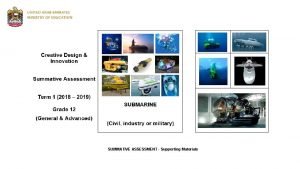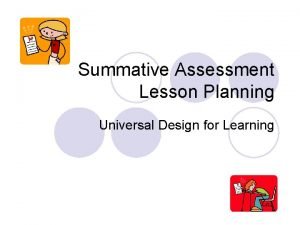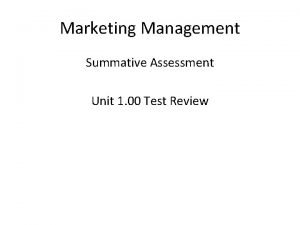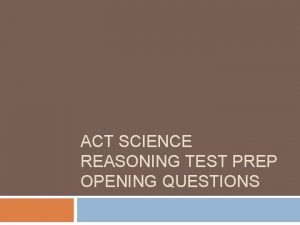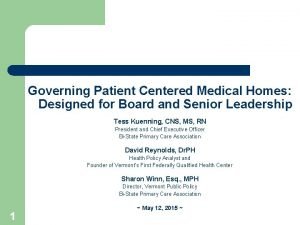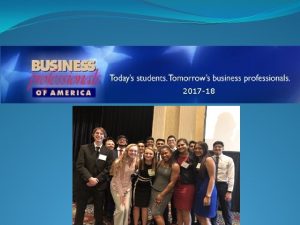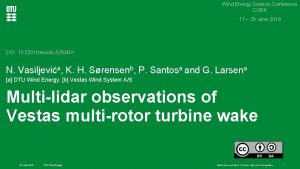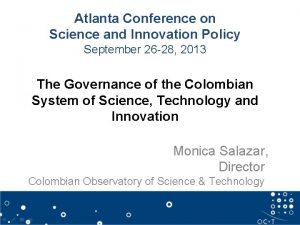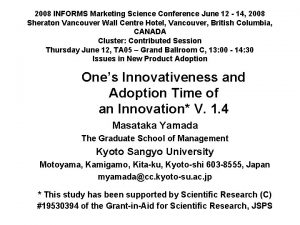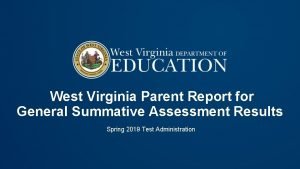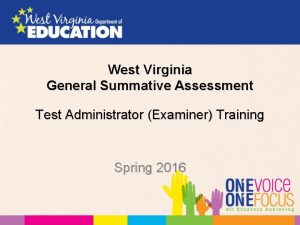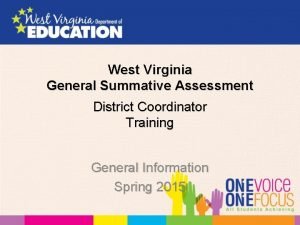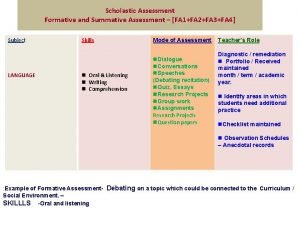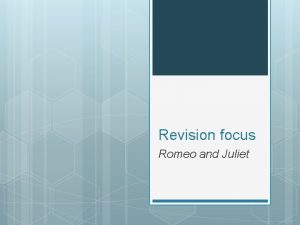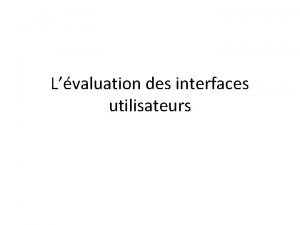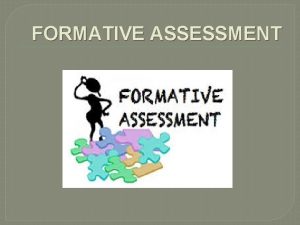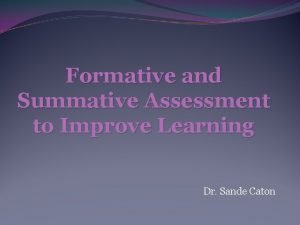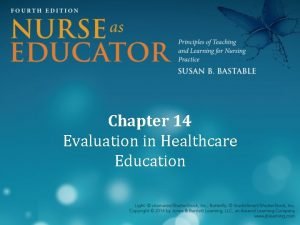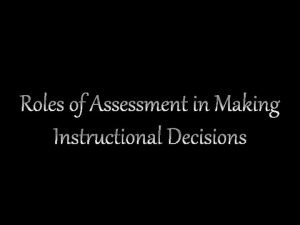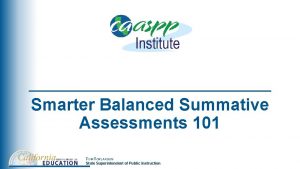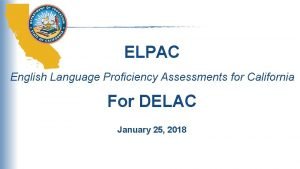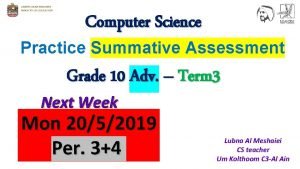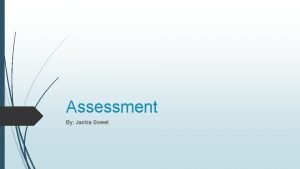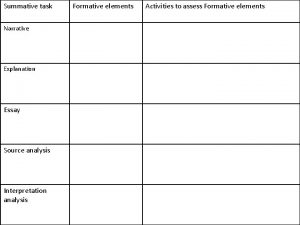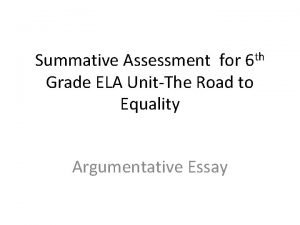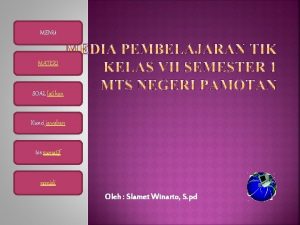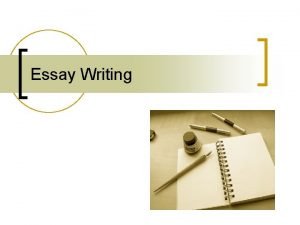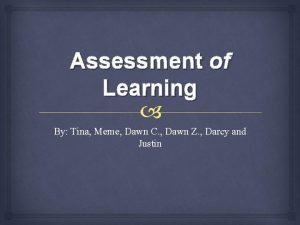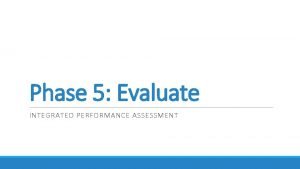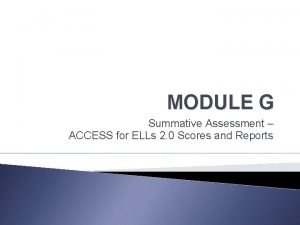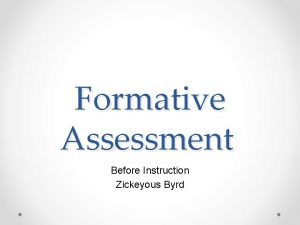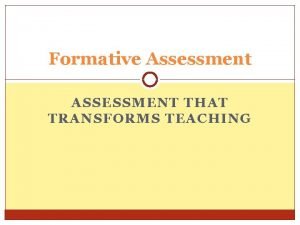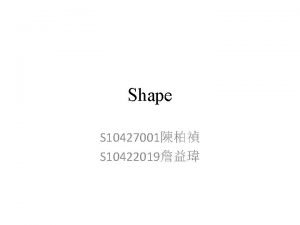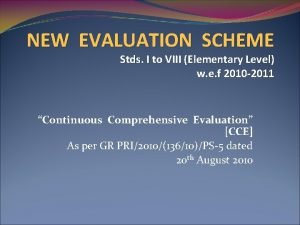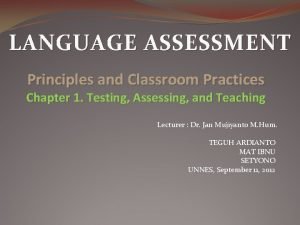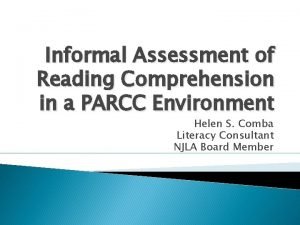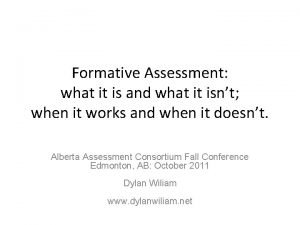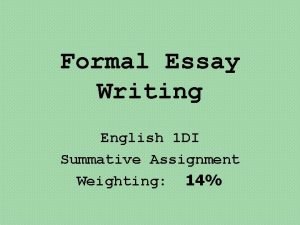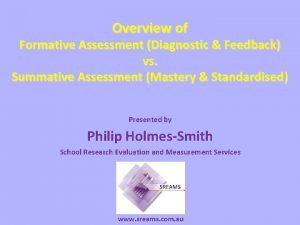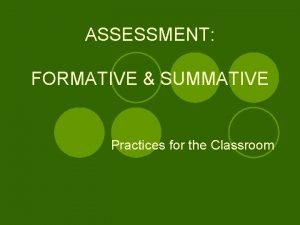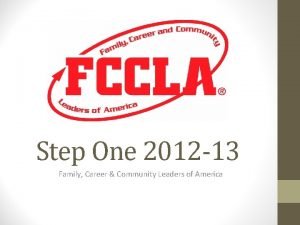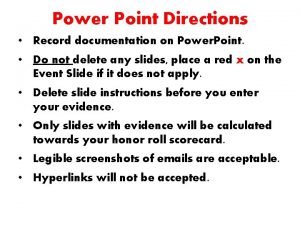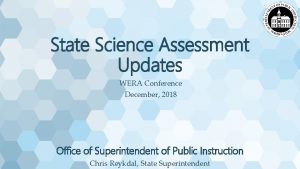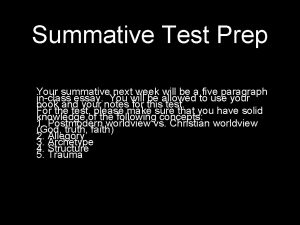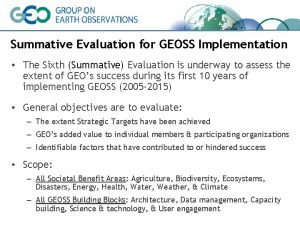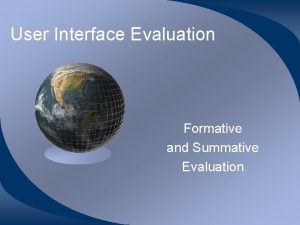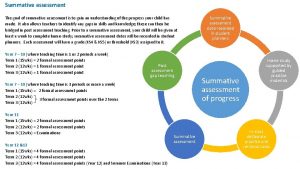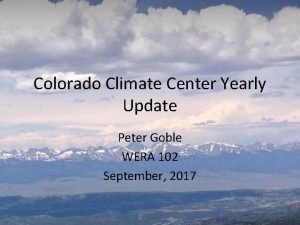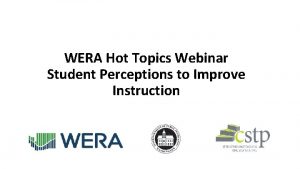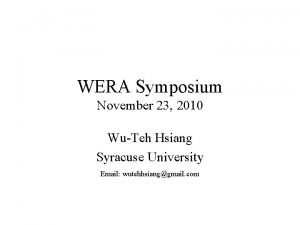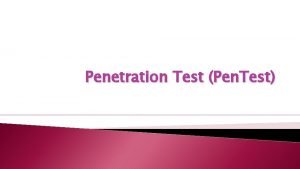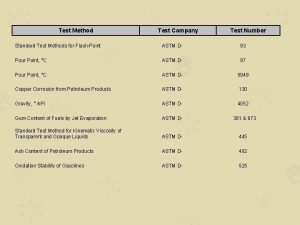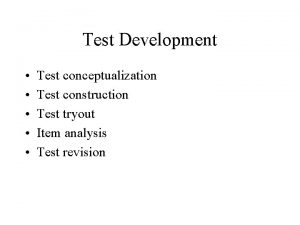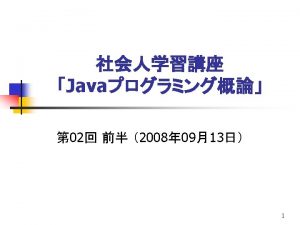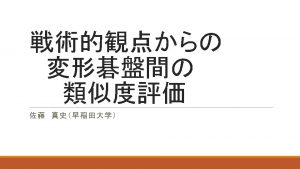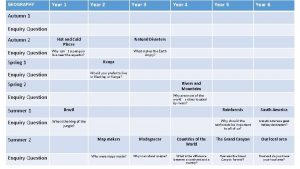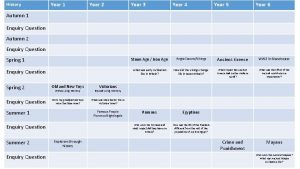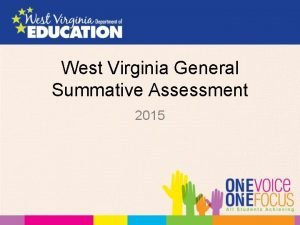State Summative Science Test Year 2 WERA Conference













































- Slides: 45

State Summative Science Test Year 2 WERA Conference December, 2019 Washington Comprehensive Assessment of Science (WCAS) Office of Superintendent of Public Instruction Chris Reykdal, State Superintendent

Welcome! Who is with us today?

Science Assessment Office Staff § General e-mail account § science@k 12. wa. us § Dawn Cope — Science Assessment Lead § dawn. cope@k 12. wa. us § Jacob Parikh—Science Assessment Specialist § jacob. parikh@k 12. wa. us § Korey Peterson—Science Assessment Specialist § korey. peterson@k 12. wa. us § Jessica Cole—Administrative Assistant § jessica. cole@k 12. wa. us

Today’s Topics § Current State Tests § WCAS Results § WCAS Design and Features § Assessment Resources § Training Test and Item Specifications Activity § WCAS Development

Current State Tests

Why do we have state tests? § The No Child Left Behind Act (NCLB) and state law require that we give a state science test once each in elementary, middle, and high school for the purpose of school and district accountability. § The Every Student Succeeds Act (ESSA) continues those same requirements.

Every Student Succeeds Act (ESSA) https: //www. k 12. wa. us/policyfunding/grants-grantmanagement/every-studentsucceeds-act-essa-implementation

House Bill (HB) 1599 § The high school science assessment graduation requirement was removed. § Students need to demonstrate their readiness for post-secondary career or college via one or more pathways. The pathways available to the Class of 2020 are: § Smarter Balanced or WA-AIM (ELA and math) § Dual credit courses in English language arts (ELA) and math § High school transition courses in ELA and math § C+ in AP, IB, or Cambridge class or achieving certain score on AP, IB, or Cambridge tests in ELA and math § ACT or SAT score § COE-Local, if completed during the 2018– 19 school year § Students must demonstrate skills via a pathway for ELA and math. The above options can be used interchangeably to meet both requirements. Alternatively, the following two pathways are considered to meet both ELA and math. § ASVAB § CTE Sequence, including completing a Core Plus branded program § Some students with disabilities may demonstrate § CIA cut-score on Smarter Balanced ("L 2 Basic") § Locally Developed Assessment (LDA) § Off-grade assessment OSPI-Graduation Requirements HB 1599

State Science Standards • Washington State adopted the Next Generation Science Standards (NGSS) as science learning standards in October of 2013. § 2013 Washington State K-12 Science Learning Standards • WCAS first administered in Spring 2018 § 5, 8, 11

NGSS Resources § Next Generation Science Standards (NGSS) § NGSS Appendices § K– 12 Framework for Science Education

Learning and Teaching Science § Ellen Ebert, Director § Ellen. Ebert@k 12. wa. us

2013 Washington State K-12 Science Learning Standards https: //www. k 12. wa. us/studentsuccess/resourcessubjectarea/science/scienc e-k%E 2%80%9312 learning-standards

Washington Comprehensive Assessment of Science (WCAS) Washington State 2013 K-12 Science Learning Standards Next Generation Science Standards (NGSS) Grade 5 Grade 8 Grade 11 3 -5 band Middle School band High School band http: //www. k 12. wa. us/Science/Standards. aspx

2020 WCAS Test Windows Grades Requirement Testing Window 5&8 Required for federal and state accountability Online: April 13 – June 5 Accommodated Paper Form: April 13 – May 22 11 Required for federal and state accountability Online: May 4 – June 5 Accommodated Paper Form: May 1 – May 22 Accommodated paper testing is available only to support large print, braille, and standard print (English and Spanish) forms for students whose IEP or 504 plan states paper. The student to Test Administrator (TA) ratio should be no greater than 3 students to 1 TA when administering the WCAS accommodated paper form. http: //www. k 12. wa. us/assessment/State. Testing/timelines-calendars. aspx

WCAS Accommodated Paper Testing • Standard forms and Spanish forms are shipped back to the vendor for processing and scoring • Large print and braille student responses are transcribed onto a standard print form before being shipped back to vendor for processing and scoring • Resources • Paper Test Administration Manual (TAM): https: //wa. portal. cambiumast. com/resources/userguides-and-manuals-testc/ • Training Module: https: //wa. portal. cambiumast. com/resources/modules-testc/ • Secure TA Script of Student Directions—shipped with test booklets

WCAS Results

Statewide WCAS Results-Grade 5 -2019 100 90 90 80 80 70 60 55 56 50 40 30 Percent Meeting Standard Grade 5 -2018 70 60 10 97% participation Attempted the Test 30 10 Attempted the Test Expected to Test 40 20 Expected to Test 54 50 20 0 53 0 93% participation

Statewide WCAS Results-Grade 8 -2019 100 90 90 80 80 70 60 53 55 50 40 30 Percent Meeting Standard Grade 8 -2018 70 60 10 96% participation Attempted the Test 30 10 Attempted the Test Expected to Test 40 20 Expected to Test 53 50 20 0 52 0 92% participation

Statewide WCAS Results-Grade 11 -2019 100 90 90 80 80 70 60 46 50 40 30 30 Percent Meeting Standard Grade 11 -2018 70 60 40 20 10 10 Expected to Test 66% participation Attempted the Test 35 30 20 0 50 50 0 Expected to Test 63% participation Attempted the Test

2018 Reporting Area Performance 2018 100 90 80 Percent Proficient 70 60 54 53 53 54 53 50 50 44 46 41 40 30 20 10 0 Grade 5 Grade 8 Grade 11 Practices and Crosscutting Concepts in Physical Sciences Practices and Crosscutting Concepts in Life Sciences Practices and Crosscutting Concepts in Earth and Space Sciences

2019 Reporting Area Performance 2019 100 90 80 Percent Proficient 70 60 50 54 49 48 50 52 47 45 40 40 44 30 20 10 0 Grade 5 Grade 8 Grade 11 Practices and Crosscutting Concepts in Physical Sciences Practices and Crosscutting Concepts in Life Sciences Practices and Crosscutting Concepts in Earth and Space Sciences

Questions to explore… How much time do kids spend on science? Is your science curriculum aligned to the NGSS? When did NGSS implementation occur? How much training has staff received on the NGSS? Did students practice with WCAS training tests? How do your results compare to the state average? Similar districts/schools? • How many students in your school/district participated in the WCAS ? • Are your scores considerably different in one reporting area? • • •

2019 Scale Score Ranges Washington Comprehensive Assessment of Science The cut (or threshold) scores for Levels 1, 2, 3, and 4 were developed by Washington educators. These cut scores were adopted by the State Board of Education in August 2018 Grades Level 1 Level 2 Level 3 Level 4 5 375 – 649 650 – 699 700 – 784 785 – 1060 8 345 – 649 650 – 699 700 – 764 765 – 1060 11 390 – 649 650 – 699 700 – 790 791 – 1190 • http: //www. k 12. wa. us/assessment/State. Testing/Scale. Scores. aspx

Scores—Communication Timeline • Scores made available in the Online Reporting System (ORS) on the WCAP Portal in August • Statewide test scores were publically released on Report Card in September • Paper WCAS Individual Score Reports (ISRs) arrived in districts in October

WCAS Design and Features

NGSS Performance Expectations per Grade Band Reporting Area Number of Three-Dimensional Performance Expectations 3 -5 Middle School High School Physical Science Domain 17 19 24 Life Science Domain 12 21 24 Earth and Space Science Domain 13 15 19 Engineering Domain 3 4 4 Total 45 59 71 Each Performance Expectation (PE) includes a Science and Engineering Practice, a Disciplinary Core Idea, and a Cross-cutting Concept

WCAS Reporting Areas Reporting Area Grade 5 Grade 8 Grade 11 Science and Engineering Practice and Cross-Cutting Concepts in Physical Sciences 17 Performance Expectations 19 Performance Expectations 24 Performance Expectations 40% 35% 36% ~14 pts ~16 pts 12 Performance Expectations 21 Performance Expectations 24 Performance Expectations 29% 38% 36% ~10 pts ~15 pts ~16 pts Science and Engineering Practice and Cross-Cutting Concepts in Earth and Space Sciences 13 Performance Expectations 15 Performance Expectations 19 Performance Expectations 31% 27% 28% ~11 pts ~13 pts Total Points 35 40 45 Science and Engineering Practice and Cross-Cutting Concepts in Life Sciences ETS PEs assessed but not included here.

Item Cluster Map

Standalone Items § Allow more PEs to be assessed on a test § Are 2 or 3 dimensional § Can have multiple parts § Computer scored item types only

WCAS Features § All online § Item Clusters and Standalone Items § Item Types: § § § Selected Response—multiple choice, multiple select Constructed Response—short answer Technology enhanced—ex: drag and drop, drop-down choices, simulations § Multi-part items § § Parts labeled with letters A, B, and C. May have a mix of item types. Parts work together. May ask for evidence to support answer in previous part of the item.

Structure and Test Length § Structure § Operational § Grades 5 and 8: 5 Clusters and 6 -12 Standalone items § High School: 6 Clusters and 6 -12 Standalone items § Counts toward a student’s score § Field test items § Embedded in the online administration § One cluster and/or standalone items § Does not count toward a student score § All items are aligned to 2 or 3 dimensions of a PE § Test Length § Grade 5: 90 minutes § Grade 8: 110 minutes § Grade 11: 120 minutes § Administration § Can be administered in multiple sessions like the Smarter Balanced ELA and Math assessments § 1 to 3 sessions recommended

Special WCAS Features § Collapsing stimuli § First stimulus is hidden when second stimulus is provided. § Both stimuli are available to the student. § Locking Items § Student can answer the question only once. § Allows subsequent questions to update with correct information. § An “attention” box warns student that they won’t be able to change their answer.

WCAS Training Tests § Help students become familiar with the features and tools of online tests. § Available on the WCAP portal. § Will be updated in late December 2019

Assessment Resources

Science Assessment Webpage https: //www. k 12. wa. us/studentsuccess/testing/statetestingoverview/washington -comprehensiveassessment-science

WCAS Educator Resources Webpage https: //www. k 12. wa. us/studen t-success/testing/state-testingoverview/washingtoncomprehensive-assessmentscience

WCAS Test Design and Item Specifications

WCAS Test Design and Item Specifications § Describe how item clusters (stimuli and items) and standalone items for the WCAS are developed to assess the NGSS § Contents Structure of the test Item Types Test organization Overview of NGSS Item specifications that describe how students can demonstrate understanding of the PEs on the state test. § Vocabulary word list § § § The documents will be updated annually based on WA educator feedback. § A modification log will be posted at each subsequent publication.

WCAS Development

Goals for WCAS § Design an assessment that reflects how science content is taught and tested in the classroom. § Use WA educators in assessment development. § Develop high quality item clusters and standalone items that achieve alignment to the SEPs, DCIs, CCCs represented in a PE or PE bundle. § Design an assessment that allows for valid and reliable inferences to be drawn from the results. § Design an assessment that ensures the fair and accurate assessment of students in special populations.

Science Assessment Development Cycle

Educator Work Group Descriptions § (2) Item Cluster Writing Workgroup: Teams of 2 -3 educators write stimuli, items, and rubrics designed to validly measure student understanding of the NGSS. § (4) Content Review Workgroup: Educators review the products of the Item Cluster Writing Workgroup to ensure that every stimulus, item, and rubric is scientifically accurate and gathers appropriate evidence about student skill with the NGSS. At the same time, a separate committee of community members reviews the items and stimuli for any bias and sensitivity issues. Recommendations from the Bias/Sensitivity Review Workgroup are considered by the Content Review Workgroup. • (6) Field Test Rangefinding : Educators look at a range of student responses to each short answer item and decide how to score each response. This educator workgroup refines scoring rubrics and produces the materials that will be used to score the field test items. • (8) Content Review with Data Workgroup: Educators use item performance data, as well as members’ science content knowledge, to decide whether each item should advance into the item bank.

Upcoming Professional Development Opportunities Event Timing Item Cluster Writing March 2020 Field Test Range Finding July 2020 Content Review August 2020 Content Review with Data September 2020

Stay informed and get involved Sign up for Science Emails or Texts messages § Go to the Subscribe page for Gov. Delivery. Enter your email address. On the Subscriptions page, select Content Areas > Science, then select Science Assessment for the grade band(s) for which you would like to receive information.

Thank you!
 Grade 12 summative test
Grade 12 summative test Summative assessment in lesson plan
Summative assessment in lesson plan Principles of marketing summative test
Principles of marketing summative test Describe your favourite subject english
Describe your favourite subject english Year 6 memories poem
Year 6 memories poem Science reasoning test
Science reasoning test Bi state primary care conference
Bi state primary care conference Bpa state leadership conference texas
Bpa state leadership conference texas Wind energy science conference 2019
Wind energy science conference 2019 Atlanta conference on science and innovation policy
Atlanta conference on science and innovation policy Informs marketing science
Informs marketing science The science of life
The science of life General summative assessment wv
General summative assessment wv Wvde tide
Wvde tide Summative scale
Summative scale Romeo and juliet summative assessment
Romeo and juliet summative assessment Respodant
Respodant Attributes of effective formative assessment
Attributes of effective formative assessment Summative
Summative Summative assessment
Summative assessment Rsa evaluation model
Rsa evaluation model Placement, formative, diagnostic and summative assessment
Placement, formative, diagnostic and summative assessment Http://www.caaspp.org
Http://www.caaspp.org Summative elpac scale score ranges
Summative elpac scale score ranges Summative assessment for the term 3 grade 10
Summative assessment for the term 3 grade 10 Sweet evaluation
Sweet evaluation Summative narrative
Summative narrative Summative paragraph
Summative paragraph Summative practice
Summative practice Essay
Essay Meme about assessment
Meme about assessment Summative assessment
Summative assessment Summative assessment
Summative assessment Examples of formative assessment
Examples of formative assessment Summative and formative assessment
Summative and formative assessment Summative modifier
Summative modifier Summative evaluation
Summative evaluation Diberikan suatu fungsi dengan persamaan y=2x-√x
Diberikan suatu fungsi dengan persamaan y=2x-√x What is summative evaluation
What is summative evaluation Example of formative assessment
Example of formative assessment Summative assessment
Summative assessment General to specific
General to specific Assessment formative summative diagnostic
Assessment formative summative diagnostic Formative vs summative
Formative vs summative What is fccla's no texting campaign called
What is fccla's no texting campaign called What is the georgia fccla state theme this year
What is the georgia fccla state theme this year
